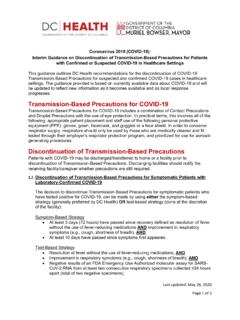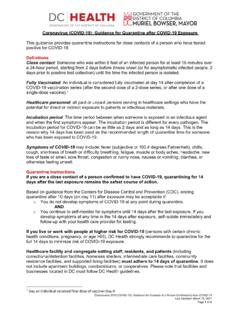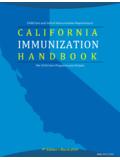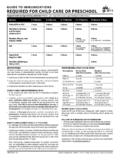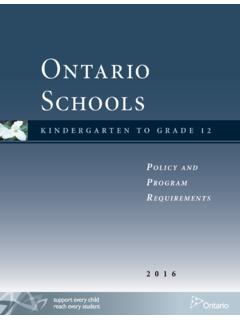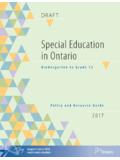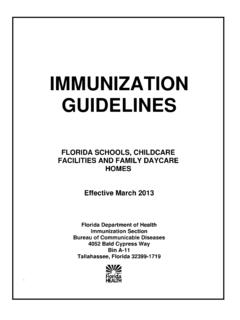Transcription of Prevention of COVID-19 in schools
1 Coronavirus 2019 ( COVID-19 ): Guidance for schools Last updated January 31, 2022 Page 1 of 18 Coronavirus 2019 ( COVID-19 ): Guidance for schools (Pre- kindergarten 12th Grade and Adult Education) This document provides guidance for how DC public, public charter, private, parochial, and independent schools can reduce the risk of COVID-19 transmission among sttrudents, staff, families, and the community. schools that offer childcare services (as distinct from Pre- kindergarten programs) should follow Guidance for Childcare Facilities at For additional information, including current District COVID-19 -related public health data, please visit Prevention of COVID-19 in schools Studies have shown that schools can remain open for in-person learning during the COVID-19 pandemic if multiple layered Prevention strategies are in place.
2 Continued use of these measures will help prevent the spread of COVID-19 in schools . schools should have a clear plan in place for virtual learning options to support changes that may be needed due to spikes in community case rates, or spread or outbreaks occurring within individual schools . Elements of Prevention schools must implement these elements in their COVID-19 Prevention strategy: o Universal indoor masking regardless of vaccination status o Staying home when sick schools should implement these elements in their COVID-19 Prevention strategy: o Promoting COVID-19 vaccination o Physical distancing Other key elements include.
3 O Hand hygiene and respiratory etiquette o Screening testing o Contact tracing, Testing, Quarantine, and Isolation1 o Cleaning and disinfection o Ventilation COVID-19 vaccination Vaccination is the most important public health intervention for ending the COVID-19 pandemic. The COVID-19 vaccine has been demonstrated to be safe and effective for children as young as 5 years old. The COVID-19 vaccine is widely available and free. o Children ages 5-17 can get the Pfizer vaccine. o People age 18 and older can get any of the 3 vaccines approved or authorized for emergency use in the United States (Pfizer, Moderna, or J&J/Janssen).
4 Any of the available vaccines are acceptable, but the CDC now preferentially recommends the mRNA vaccines (Pfizer and Moderna) over the J&J/Janssen vaccine for the primary 1 Quarantine: The process of separating individuals who have been exposed to an infectious agent (like COVID-19 ) before they develop symptoms of infection or test positive for infection, for the duration of time that covers the incubation period for the pathogen to prevent further spread. Isolation: The process of separating individuals with symptoms of an infection or confirmed diagnosis of an infection (like COVID-19 ) away from others, to prevent spread of a pathogen.
5 Coronavirus 2019 ( COVID-19 ): Guidance for schools Last updated January 31, 2022 Page 2 of 18 vaccine series2 as well as for booster doses. All people age 12 and older should also get a COVID-19 booster shot. o People age 12 to 17 can get the Pfizer booster shot 5 months after they complete their primary vaccine series. o People 18 and older are recommended in most situations to get boosted with either one of the mRNA vaccines (Pfizer or Moderna) 5 months after they complete their primary vaccine series (regardless of what vaccine they had for their primary vaccine series). Find out more about: o COVID-19 vaccines: o Booster shots: All adults who are regularly in schools , except for students who are 18 and older, must be vaccinated unless they were granted a medical or religious exemption.
6 There is no test out option. This applies to all DC Public schools , DC public charter schools , independent schools , private schools , and parochial schools . All student-athletes aged 12 and older must be vaccinated to participate in school-based sports, unless they have been granted a medical or religious o This does not pertain to athletics at DPR facilities or to private club sports and activities, unless they train or compete at school facilities in DC. o For more information on student-athlete vaccine requirements, see COVID-19 Vaccination Mandate Guidance for Student-Athletes available at All other students age 5 and older are strongly encouraged to get vaccinated and stay up to date on their COVID-19 vaccine.
7 schools are encouraged to track vaccination coverage among students and staff, while complying with applicable privacy regulations. School administrators should strongly promote vaccination and develop policies that support vaccination, such as: o Leave options for staff and excused absences for students to get vaccinated, and for if they experience vaccine side effects o Creative incentives for staff and students to get vaccinated o For more information about how to promote vaccination, see In the school setting, the following are considered up to date on their COVID-19 vaccine: o People 18 and older who have received all recommended vaccine doses, including booster doses as o Children age 5-17 who have completed their primary vaccine series.
8 Find out more about getting the COVID-19 vaccine in DC at For more information about the COVID-19 vaccine mandates, see Mayor s Order 2021-109, available on 2 The initial vaccine course before any extra ( , booster ) doses 3 Note: Students who are not up to date on their COVID-19 vaccine may not participate in wrestling, even if they have received a medical or religious exemption to the vaccine. 4 For detailed information about staying up to date on your COVID-19 vaccine, see Coronavirus 2019 ( COVID-19 ): Guidance for schools Last updated January 31, 2022 Page 3 of 18 Stay home when sick Any person experiencing symptoms of COVID-19 (see page 3) or who is required to isolate or quarantine due to COVID-19 diagnosis or exposure must not attend, work at, or visit a school due to the risk of exposing others.
9 O A person who is awaiting a COVID-19 test due to symptoms of COVID-19 must not attend, work at, or visit a school until their test comes back negative. (For more information see ISOLATION section on page 13). o People who are unvaccinated or not up to date on their COVID-19 vaccine who have travelled should follow travel-related COVID-19 testing and quarantine recommendations outlined in Guidance for Travel at Symptoms of COVID-19 may include: fever (subjective or degrees Fahrenheit or greater), chills, cough, shortness of breath or difficulty breathing, fatigue, muscle or body aches, headache, new loss of taste or smell, sore throat, congestion or runny nose, nausea or vomiting, or diarrhea, All persons 18 and older, regardless of vaccination status, who are experiencing any of the symptoms listed above, that are new or unexplained, must stay home and not enter a school.
10 All persons younger than 18, regardless of vaccination status, who are experiencing the following symptoms, that are new or unexplained, must stay home and not enter a school (Modified Protocol): o Any ONE of these red flag symptoms: Fever (measured at F or greater, or subjective) New or worsening cough Shortness of breath/difficulty breathing New loss of taste or smell o OR at least two (2) of the following symptoms: Chills Muscle or body aches Headache Sore throat An unusual amount of tiredness Nausea or vomiting Runny nose or congestion Diarrhea Masks Mask basics: Masks function as a simple barrier to help prevent respiratory droplets from traveling into the air and onto other people when the person wearing the mask coughs, sneezes, talks, or raises their voice.
